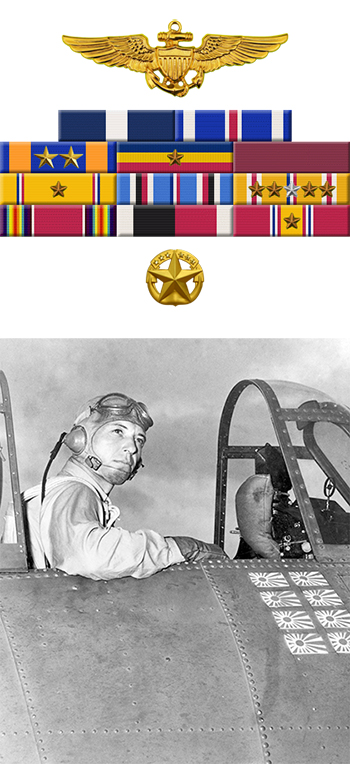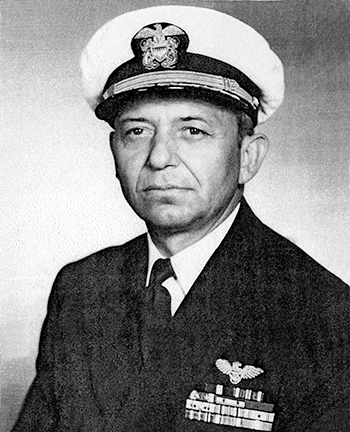
|
Donald E. Runyon |
 |
|||
| Rank, Service | ||||
Commander O-5, U.S. Navy |
||||
| Veteran of: | ||||
|
||||
| Tribute: | ||||
Donald Runyon was born on June 26, 1913, in Fairmount, Illinois. He enlisted in the Indiana National Guard on March 28, 1933, and served until July 5, 1934. Runyon then enlisted in the U.S. Navy on July 10, 1934, and completed basic training and "A" School at NTS Norfolk, Virginia, in April 1935. His first assignment was in General Service and then with the Aviation Unit aboard the cruiser USS Chester (CA-27) from April 1935 to June 1937, followed by Flight School as an Enlisted Pilot at NAS Pensacola, Florida, from June 1937 to April 1938. Runyon served as an enlisted SBD Dauntless pilot with VT-6 aboard the aircraft carrier USS Enterprise (CV-6) from April 1938 to November 1940, and then as an enlisted F2A Buffalo and F4F Wildcat pilot with VF-2 aboard the aircraft carrier USS Lexington (CV-2) from November 1940 to June 1942. He was commissioned an Ensign on June 15, 1942, and then served as an F4F pilot with VF-6 aboard the aircraft carrier USS Enterprise (CV-6) from June to October 1942. During this time he was credited with the destruction of 8 enemy aircraft in aerial combat during August 1942. Ens Runyon next served with VF-3 aboard the aircraft carrier USS Saratoga (CV-3) from October 1942 to September 1943, followed by service as an F6F Hellcat pilot with VF-18 aboard the aircraft carrier USS Bunker Hill (CV-17) from September 1943 to April 1944. During this time he was credited with the destruction of another 3 enemy aircraft in aerial combat, for a total of 11 enemy aircraft destroyed during World War II. He also flew some missions from the British aircraft carrier HMS Victorious in 1943. LT Runyon served as a Flight Test Officer at NATC Patuxent River, Maryland, from April 1944 to July 1945, and then as an Engineering Test Pilot at Ames Research Center at Moffet Field, California, from July 1945 to July 1946. His next assignment was as a Hangar Officer aboard the aircraft carrier USS Randolph (CV-15) from July to October 1946, followed by service as an F4U Corsair pilot and Operations Officer with VBF-18 aboard the Randolph from October 1946 to February 1947. He served as an F4U pilot and Executive Officer with VF-17A aboard the Randolph from February to July 1947, and then as an FH Phantom pilot and Gunnery Officer with VF-171 aboard the Randolph from July 1947 to November 1948. LCDR Runyon next served as a Flight Test Project Officer at NATC Patuxent River from November 1948 to June 1951, followed by service as Operations Officer with VX-3 at NAS Atlantic City, New Jersey, from July 1951 to July 1952. He served as an F2H-2 Banshee pilot and as Commanding Officer of VF-22 aboard the attack aircraft carrier USS Lake Champlain (CVA-39) from July 1952 to March 1953, and then with Fleet Aircraft Service Squadron 6 (FASRON-6) at NAS Jacksonville, Florida, from March to July 1953. His next assignment was as VF Design Project Officer with the U.S. Navy Bureau of Aeronautics from July 1953 to May 1956, followed by service as Commanding Officer of FASRON-2 at NAS Quonset Point, Rhode Island, from June 1956 to June 1957. CDR Runyon served as Operations Officer with Heavy Attack Wing ONE at NAS Sanford, Florida, from July 1957 to June 1959, and then as Operations Officer with Naval Air Development Center Johnsville, Pennsylvania, from June 1959 to June 1961. His final assignment was as Operations Officer at NAS Quonset Point from July 1961 until his retirement from the Navy on July 1, 1963. Donald Runyon Flew West on December 25, 1984, and was buried at Arlington National Cemetery. |
||||
|
||||

